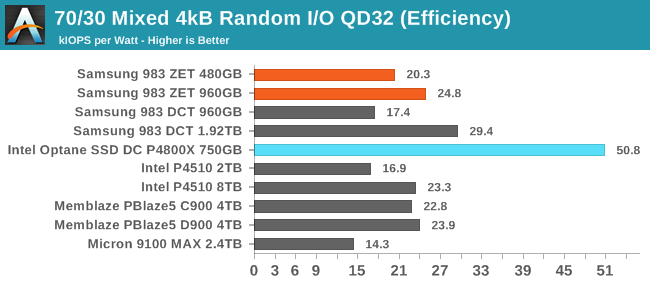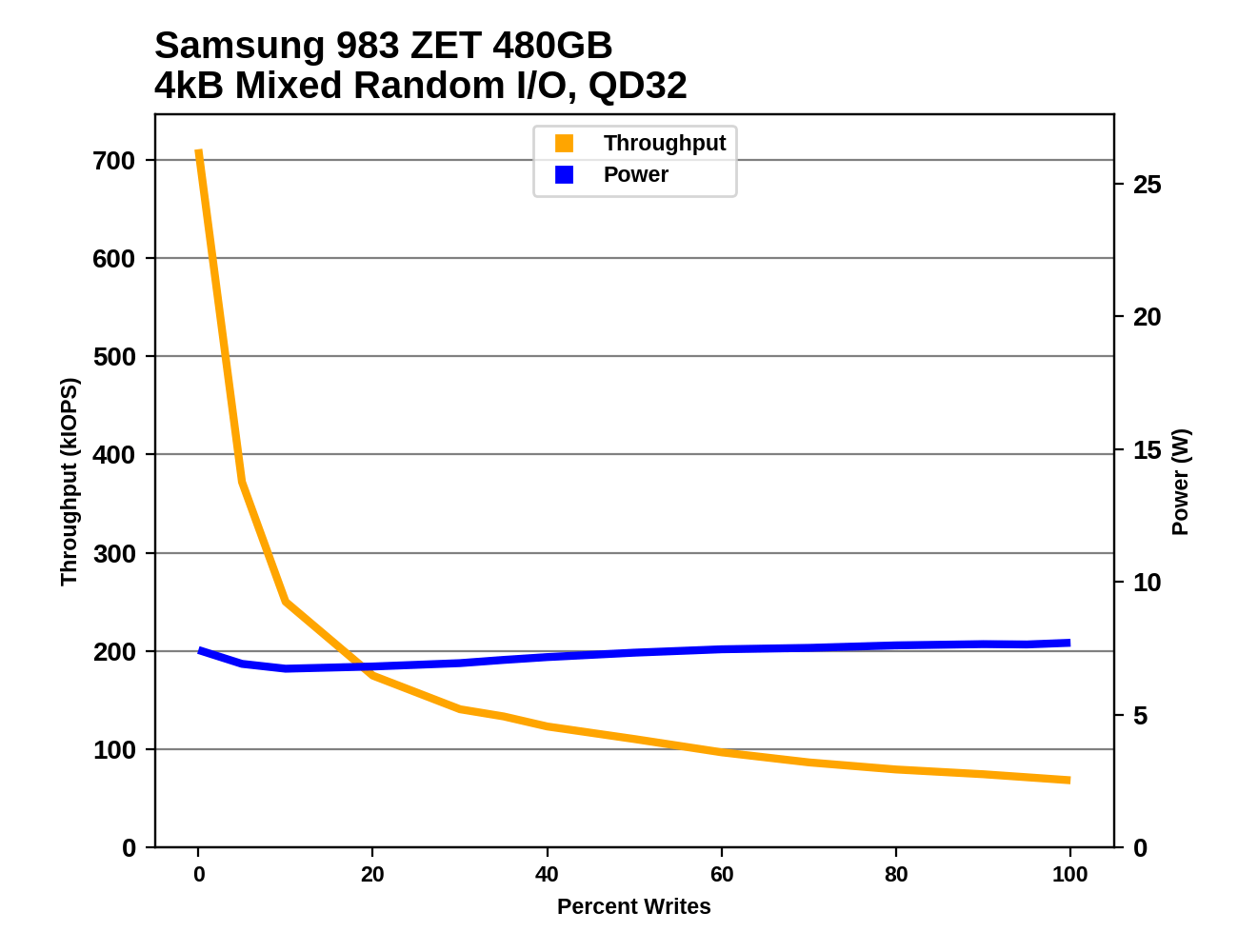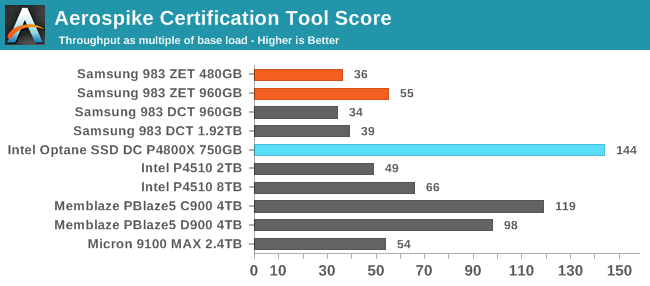The Samsung 983 ZET (Z-NAND) SSD Review: How Fast Can Flash Memory Get?
by Billy Tallis on February 19, 2019 8:00 AM ESTMixed Random Performance
Real-world storage workloads usually aren't pure reads or writes but a mix of both. It is completely impractical to test and graph the full range of possible mixed I/O workloads—varying the proportion of reads vs writes, sequential vs random and differing block sizes leads to far too many configurations. Instead, we're going to focus on just a few scenarios that are most commonly referred to by vendors, when they provide a mixed I/O performance specification at all. We tested a range of 4kB random read/write mixes at queue depths of 32 and 128. This gives us a good picture of the maximum throughput these drives can sustain for mixed random I/O, but in many cases the queue depth will be far higher than necessary, so we can't draw meaningful conclusions about latency from this test. As with our tests of pure random reads or writes, we are using 32 (or 128) threads each issuing one read or write request at a time. This spreads the work over many CPU cores, and for NVMe drives it also spreads the I/O across the drive's several queues.
The full range of read/write mixes is graphed below, but we'll primarily focus on the 70% read, 30% write case that is a fairly common stand-in for moderately read-heavy mixed workloads.
 |
|||||||||
| Queue Depth 32 | Queue Depth 128 | ||||||||
On the 70/30 mixed random IO tests, the Samsung 983 ZET provides similar performance to a TLC-based 983 DCT of twice the capacity. This leaves both Samsung drives as among the slowest drives in this batch, because the other flash-based drives are mostly higher-capacity models using controllers with higher channel counts than the Samsung Phoenix. The Samsung drives perform about the same at QD128 as at QD32, while some of the larger drives take advantage of the higher queue depth to almost catch up to the Intel Optane SSD.
 |
|||||||||
| QD32 Power Efficiency in MB/s/W | QD32 Average Power in W | ||||||||
| QD128 Power Efficiency in MB/s/W | QD128 Average Power in W | ||||||||
The TLC-based 1.92TB 983 DCT uses the least power on these mixed IO tests and it ends up with some of the best efficiency scores among the flash-based SSDs, about 60% of the performance per Watt that the Intel Optane SSD provides. The two 983 ZET drives use a bit more power than the 983 DCT, so they end up with fairly ordinary efficiency scores that are outclassed by the largest TLC drives in the QD128 test.
 |
|||||||||
| QD32 | |||||||||
| QD128 | |||||||||
The Samsung 983 ZET starts off the mixed IO tests with extremely high random read performance, but the performance drops very steeply as writes are added to the mix—just 5% writes is enough to almost cut total throughput in half, and the advantage of Z-NAND is gone by the time the workload is 20% writes. Except on the most read-heavy workloads, the flash-based SSDs are limited largely by their steady-state write performance, and the 983 ZET is handicapped there by its low overall capacities.
Aerospike Certification Tool
Aerospike is a high-performance NoSQL database designed for use with solid state storage. The developers of Aerospike provide the Aerospike Certification Tool (ACT), a benchmark that emulates the typical storage workload generated by the Aerospike database. This workload consists of a mix of large-block 128kB reads and writes, and small 1.5kB reads. When the ACT was initially released back in the early days of SATA SSDs, the baseline workload was defined to consist of 2000 reads per second and 1000 writes per second. A drive is considered to pass the test if it meets the following latency criteria:
- fewer than 5% of transactions exceed 1ms
- fewer than 1% of transactions exceed 8ms
- fewer than 0.1% of transactions exceed 64ms
Drives can be scored based on the highest throughput they can sustain while satisfying the latency QoS requirements. Scores are normalized relative to the baseline 1x workload, so a score of 50 indicates 100,000 reads per second and 50,000 writes per second. Since this test uses fixed IO rates, the queue depths experienced by each drive will depend on their latency, and can fluctuate during the test run if the drive slows down temporarily for a garbage collection cycle. The test will give up early if it detects the queue depths growing excessively, or if the large block IO threads can't keep up with the random reads.
We used the default settings for queue and thread counts and did not manually constrain the benchmark to a single NUMA node, so this test produced a total of 64 threads scheduled across all 72 virtual (36 physical) cores.
The usual runtime for ACT is 24 hours, which makes determining a drive's throughput limit a long process. For fast NVMe SSDs, this is far longer than necessary for drives to reach steady-state. In order to find the maximum rate at which a drive can pass the test, we start at an unsustainably high rate (at least 150x) and incrementally reduce the rate until the test can run for a full hour, and then decrease the rate further if necessary to get the drive under the latency limits.

The Samsung 983 ZET outscores its TLC-based sibling 983 DCT, but doesn't beat the throughput that the larger TLC drives provide. There's enough write activity in this test to seriously limit the performance of the Z-SSDs, and so the drives with higher channel counts and much more capacity overall can pull ahead. The Intel Optane SSD DC P4800X still provides the best score on this test, 2.6 times that of the larger 983 ZET and 21% faster than the fastest flash-based SSD we have on hand.
 |
|||||||||
| Power Efficiency | Average Power in W | ||||||||
The 983 ZET and 983 DCT have similar power consumption during this test, and both use substantially less power than the other SSDs in this batch. That doesn't translate to any big advantage in power efficiency, though the larger 983 ZET does provide the second-best efficiency score among the flash-based SSDs. The Optane SSD provides 50% better performance per Watt than any of the flash-based SSDs.










44 Comments
View All Comments
eddman - Tuesday, February 19, 2019 - link
It's certainly better than other flash solutions but this is supposed to compete with optane and yet is unable to beat or match it in use cases that matter.I don't see customers, looking for absolute performance in those use cases, choosing this over optane even at these lower prices. Endurance seems to be lower too.
P.S. I remember comments from people, specially a certain individual, vehemently claiming that SLC can easily compete with 3D xpoint and that companies are simply not bothering with making it happen because the money is in MLC/TLC only.
Kracer - Tuesday, February 19, 2019 - link
Is the Samsung 3D NAND Comparison table right?9x layer nand has the same capacity as 48 layer.
Billy Tallis - Tuesday, February 19, 2019 - link
These days, Samsung is making both 256Gb and 512Gb TLC parts, but the data shown is what they announced for the 256Gb 9xL part. The higher density of the newer generations means the die size is smaller for the same capacity, but I don't have those numbers and don't feel like decapping any of my working drives to measure.Kracer - Wednesday, February 20, 2019 - link
Huh, ok.Thanks for the reply.
Samus - Tuesday, February 19, 2019 - link
You can buy SIX 480GB Enterprise-class eMLC drives with around half the write endurance and slightly less performance for the same price. That means you could double up TWO drives 3x in varying configurations or RAID to have similar endurance.The margins on this thing must be ridiculous. We thought X-point prices were out of this world but this is out of this galaxy. It would be competitive at HALF the price, but the fact is X-point is better and somehow, shockingly, its actually cheaper!?
PeachNCream - Tuesday, February 19, 2019 - link
Why would prices need to be in this galaxy when we're talking about a Samsung Galaxy instead?Sorry, I couldn't resist...I'll leave now.
eastcoast_pete - Tuesday, February 19, 2019 - link
Definitely NOT a consumer drive.@Billy Regarding the Optane drive performance: any information or experience with DIMM format Optane? I believe Intel launched DDR4 slot format compatible Optane modules. How much faster are they than the PCI-E drives?
ksec - Tuesday, February 19, 2019 - link
I don't think any consumer would be interested in these. Would love ServeTheHome doing some DB testing with it. Looking at the price and performance I think that is going to Win a lot of business from Optane. NAND price are dropping as well, so Samsung would have lots of capacity for Shipment.MamiyaOtaru - Tuesday, February 19, 2019 - link
where's ddriver? He was constantly banging on about how terrible "hypetane" is (and how clever he was for coming up with that nickname) and how SLC would kick its ass""no other alternative nonvolatile memory technology is close to being ready to challenge 3D XPoint"
Except for SLC, which was so good it was immediately abandoned once inferior and more profit friendly NAND implementations were available.
A SLC based product coupled with MRAM cache will easily humiliate hypetane in its few strong aspects."
https://www.anandtech.com/show/11953/the-intel-opt...
I am still disappointed by optane, and now I'm disappointed by znand (performance and price). Wish we had some non-volatile memory that was affordable and not trending towards more and more fragility (QLC)
JoeyJoJo123 - Tuesday, February 19, 2019 - link
Looks like I'm not the only one that remembers the absurdity in trying to bring back SLC for common end user machines.The price/GB says it all. It's for enterprise or extreme enthusiasts only, and that's fine, because these deep wallet customers push the industry forward. It's just at the end of the day, if you need the best, you need to pay to get the best. Whining about MLC/TLC/QLC/Optane etc doesn't make the end-user products better.